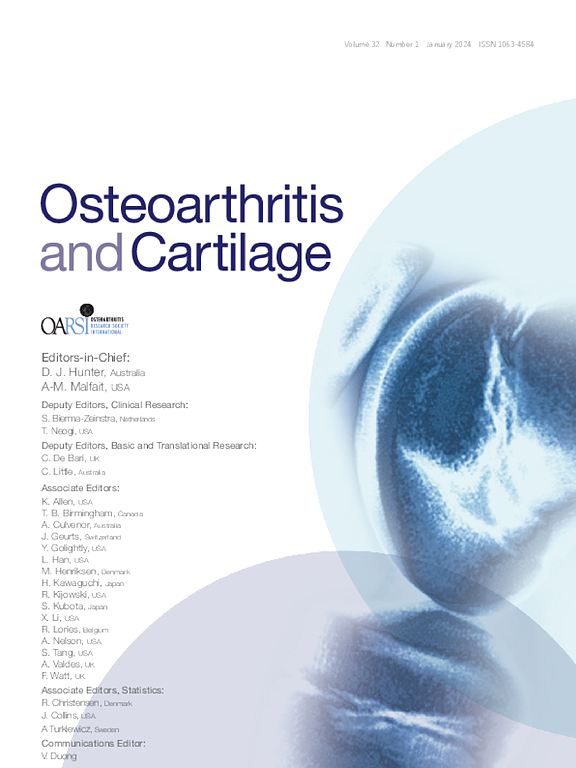多中心改良德尔菲练习:确定早期症状性膝骨关节炎的候选分类项目
IF 7.2
2区 医学
Q1 ORTHOPEDICS
引用次数: 0
摘要
目的:设计:我们与 OA 临床医生和研究人员("OA 专家")进行了三轮国际在线改良德尔菲练习:设计:我们与 OA 临床医生和研究人员("OA 专家")进行了三轮国际在线改良德尔菲练习。在第一轮中,参与者审查了 84 个候选项目,并提名了对 EsSKOA 分类可能有用的其他项目;≥ 3 名参与者提名的项目被添加进来。在第二轮中,参与者对 108 个项目的有用性进行评分(1 分[完全没用]至 9 分[非常有用])。在第三轮中,参与者可以在查看第二轮小组中位数和四分位数后修改自己的评分。第 3 轮后,我们保留了有用性中位数大于 5 分且≥33.3% 的参与者将该项目归类为有用(7 至 9 分)的项目,包括总体和按临床医生领域进行的分组分析:第一轮共有 128 名参与者,其中 113 人(88%)完成了所有轮次。我们保留了 77 个项目,涵盖多个领域(人口统计学、症状、体格检查、基于表现的测量、影像学、实验室检查和大体检查/关节镜检查)。评分较高的项目包括(有用性评分中位数):既往膝关节损伤(8 分)、不同关节的 OA 诊断(7 分)和与活动相关的膝关节疼痛(7 分)。四分位数间距多为 3.结论:我们确定了 77 个 OA 专家认为对 EsSKOA 分类可能有用的项目。结果凸显了专家对项目有用性的不确定性。接下来,将使用数据驱动和多标准决策分析方法进一步评估和减少候选项目。本文章由计算机程序翻译,如有差异,请以英文原文为准。
Multi-centre modified Delphi exercise to identify candidate items for classifying early-stage symptomatic knee osteoarthritis
Objective
To generate a list of candidate items potentially useful for discriminating individuals with Early-stage Symptomatic Knee Osteoarthritis (EsSKOA) from those with other conditions and from established osteoarthritis (OA), and to reduce this list based on expert consensus.
Design
We conducted a three-round online international modified Delphi exercise with OA clinicians and researchers (“OA experts”). In Round 1, participants reviewed 84 candidate items and nominated additional item(s) potentially useful for EsSKOA classification; those nominated by ≥3 participants were added. In Round 2, participants rated perceived usefulness of 108 items (1 [not at all useful] to 9 [extremely useful]). In Round 3, participants could revise their ratings after reviewing Round 2 group median and quartiles. Following Round 3, we retained items with a median usefulness score >5 and ≥33.3% of participants categorised the item as useful (7 to 9), overall and in subgroup analysis by clinician field.
Results
There were 128 participants in Round 1 and 113 (88%) completed all rounds. We retained 77 items that spanned multiple domains (demographics, symptoms, physical exam, performance-based measures, imaging, laboratory investigations, and gross inspection/arthroscopy). Highly rated items included (median usefulness score): prior knee joint injury (8), diagnosis of OA in a different joint (7), and activity-related knee pain (7). The interquartile range was most often 3.
Conclusion
We identified 77 items that OA experts consider potentially useful for EsSKOA classification. The results highlight experts’ uncertainty around item usefulness. Next, candidate items will be further assessed and reduced using data-driven and multicriteria decision analysis methods.
求助全文
通过发布文献求助,成功后即可免费获取论文全文。
去求助
来源期刊

Osteoarthritis and Cartilage
医学-风湿病学
CiteScore
11.70
自引率
7.10%
发文量
802
审稿时长
52 days
期刊介绍:
Osteoarthritis and Cartilage is the official journal of the Osteoarthritis Research Society International.
It is an international, multidisciplinary journal that disseminates information for the many kinds of specialists and practitioners concerned with osteoarthritis.
 求助内容:
求助内容: 应助结果提醒方式:
应助结果提醒方式:


